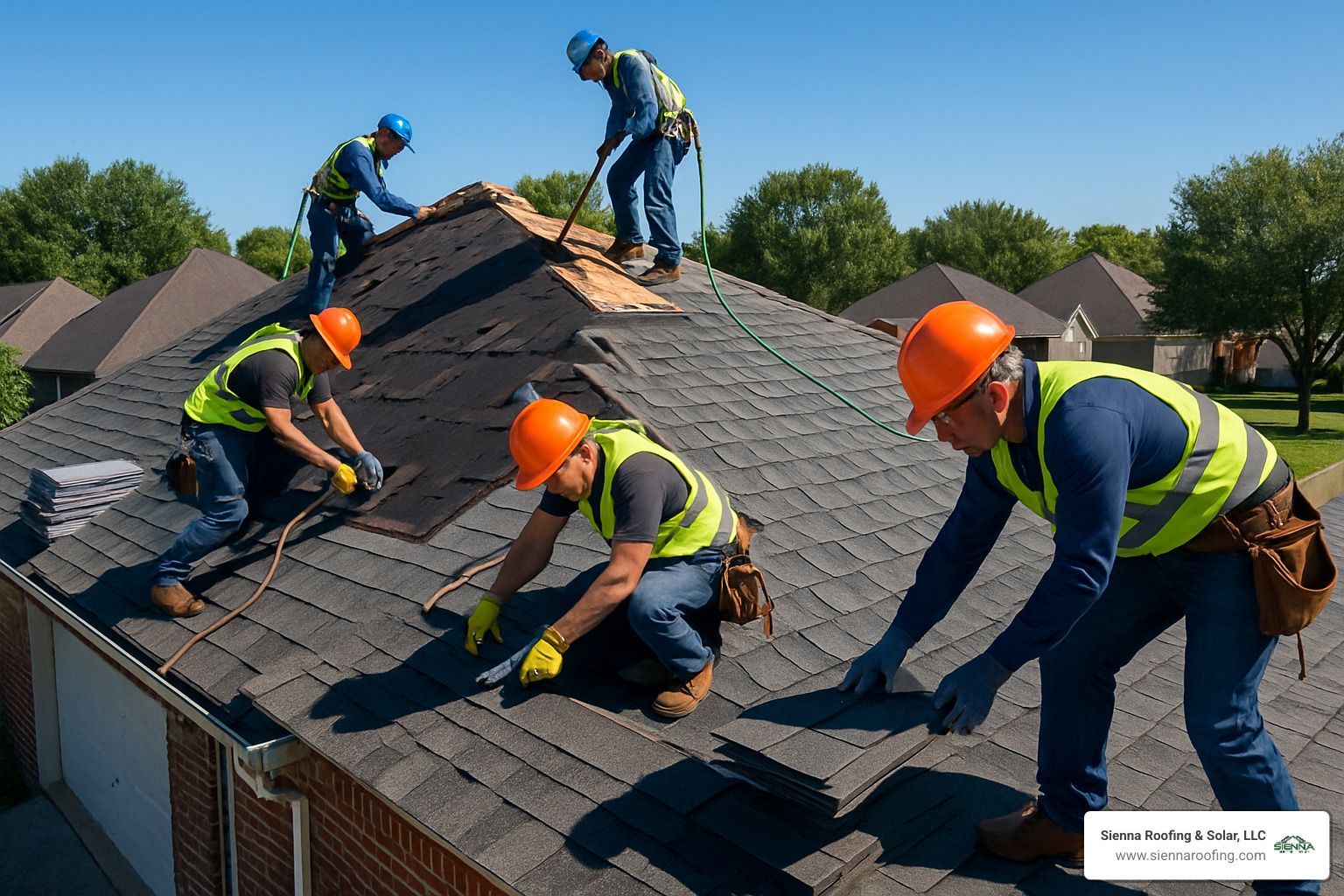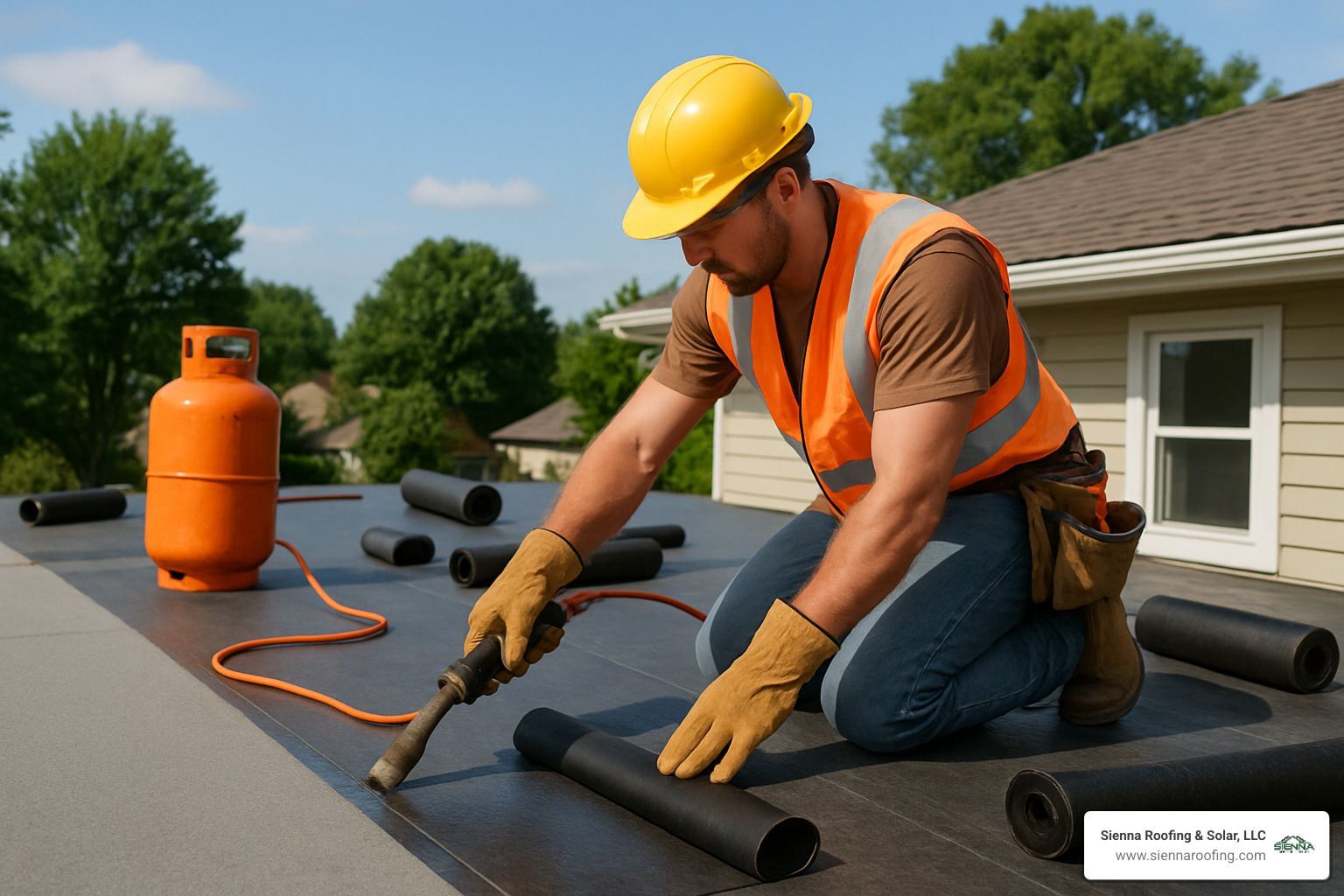After the Storm: How to Handle Roof Storm Damage Repair

Andre Castro
Owner of Sienna Roofing
When Storms Strike: Your Roof Recovery Guide
If you're dealing with roof storm damage repair needs, here's what you need to know right away:
- Safety first- Stay away from damaged areas and turn off power if water is present
- Document everything- Take photos of all damage before moving anything
- Temporary protection- Cover damaged areas with tarps (extending 4 feet beyond damage)
- Contact insurance- File a claim promptly and understand your policy type (ACV vs RCV)
- Hire professionals- Select a licensed, local contractor with storm damage experience
When severe weather hits your home, time is truly of the essence. Roof storm damage repair isn't something most homeowners think about until they're staring at water dripping from their ceiling or noticing missing shingles in their yard after a powerful storm. The reality is that storm damage can quickly escalate from a minor inconvenience to a major structural threat if not addressed promptly.
Storms can wreak havoc on your roof through multiple avenues - from wind lifting and tearing away shingles, to hail leaving divots and dents, to heavy rainfall finding its way through previously unnoticed vulnerabilities. What might start as a small leak can rapidly develop into extensive water damage, mold growth, and compromised structural integrity.
Most homeowners insurance policies cover storm-related roof damage, but coverage levels vary significantly based on your specific policy terms and the age of your roof. Understanding whether you have Actual Cash Value (ACV) or Replacement Cost Value (RCV) coverage makes a tremendous difference in your out-of-pocket expenses.
I'm Andre Castro, founder of Sienna Roofing & Solar, LLC, and with over five years of experience handling roof storm damage repair projects throughout the Houston Metro area, I've seen how prompt, professional response can save homeowners thousands in secondary damage costs.

Roof Storm Damage Repair 101: Types, Causes & Hidden Dangers
Here's something most Houston homeowners don't realize until it's too late: storm damage isn't always dramatic. Often, it's the subtle, hidden damage that causes the most trouble down the road. That small leak might seem minor today, but give it a few weeks of Houston humidity, and you could be facing a much bigger problem.
Every year, severe weather events cause billions in property damage across America. Understanding exactly what kind of storm damage your roof has suffered is crucial for proper repairs and insurance claims.
Hail, Wind & Debris—Spot the Signs Fast
Hail is nature's sneaky destroyer. Those innocent-looking ice balls can hit your roof at speeds up to 100 mph, creating damage that's easy to miss from ground level. On asphalt shingles, hail typically leaves behind dark spots or "bruises" where protective granules have been knocked away.
After a hailstorm, look for dark bruising on shingles, dents in metal vents and flashing, granules collecting in gutters, and small divots across your roof surface. These might seem cosmetic, but they've actually compromised your roof's first line of defense.
Wind damage is more than just missing shingles. Even moderate winds can create "uplift" – breaking the seal between shingles and loosening fasteners without visibly removing materials. Your roof might look intact while actually being vulnerable to water intrusion.
Keep an eye out for curled or lifted shingle edges, granule loss in wind-direction patterns, and visibly missing or loose shingles.

Rain, Snow & Ice—Water Is Your Worst Enemy
While we rarely see snow in Houston, our heavy rainfall presents serious challenges. Water is truly your home's worst enemy – it finds the smallest vulnerabilities and exploits them, spreading damage throughout your structure.
Rain damage often reveals pre-existing weaknesses in your roof. Watch for water stains on ceilings or walls, damp spots in attic insulation, curled shingles that create entry points, and mold growth in your attic space.
For our neighbors who experience occasional freezing temperatures, ice dams can be devastating. These form when heat escapes from your attic, melts roof snow, which then refreezes at the eaves, creating a barrier that traps water and forces it under shingles.
Tree & Impact Damage—When Nature Falls Hard
When trees and large branches come down during storms, they create some of the most severe and immediate roof damage. Unlike hail or wind damage that might develop slowly, impact damage demands emergency attention.
After a storm with high winds, look for visible punctures through roofing materials, cracked structural supports, sagging sections of your roof, or large debris still resting on your roof surface.
Safety becomes paramount with tree damage. Always remember to:
- Never attempt to remove large branches or trees yourself
- Establish a safety perimeter around damaged areas
- Contact emergency services if power lines are involved
- Get professional tree removal before roof repairs begin
Learn more about our roofing repair services
Step-by-Step Response Plan After a Storm Hits
When Mother Nature releases her fury on your home, knowing exactly what to do can save you thousands in unnecessary damage. The hours immediately following a storm are critical for preventing further damage.
First 24 Hours Checklist
Safety must come first—always. If you see water near electrical outlets or appliances, immediately turn off your home's power at the main breaker. If your home shows signs of structural damage like sagging ceilings or cracked walls, evacuate until professionals can assess the situation.
Document everything before you touch anything. "The photos you take today will be worth their weight in gold when dealing with insurance." Capture clear images from multiple angles, including close-ups of damaged areas and wider shots showing the overall impact. Don't forget to photograph interior damage too.
While waiting for professional help, take simple steps to prevent further damage. Move valuable furniture and electronics away from leaks, position buckets to catch dripping water, and keep all receipts for emergency supplies—your insurance may reimburse these costs.
Contact your insurance company immediately. After major storms, claims departments get flooded with calls, so the sooner you reach out, the better. Get your claim number and your adjuster's direct contact information.

DIY Vs. Pro: Safe Roof Inspection Techniques
While we recommend professional inspection after storm damage, you can assess the situation yourself before help arrives using the I.O.U. method:
Start Inside your home during daylight hours. Check your attic for pinpoints of light coming through the roof, wet insulation, water stains, or any sagging in the roof deck.
Next, examine your home from the Outside, keeping your feet on the ground. Walk the perimeter and use binoculars for a closer look. Check for missing shingles, fallen debris, and granules in gutters or on your lawn.
Only consider going Up the ladder if weather conditions are completely clear and you have proper safety equipment. Always have someone hold the ladder, and never walk on a wet or visibly damaged roof.
More info about roof inspection
Temporary Measures to Prevent Escalating Damage
While waiting for our team to arrive, taking the right temporary measures can prevent minor damage from becoming major:
Proper tarping technique is crucial. Use heavy-duty, UV-resistant tarps and follow the "4-foot rule"—extend your tarp at least 4 feet beyond the damaged area in all directions. Secure your tarp with 2x4 boards laid along the edges rather than driving nails, which create more holes.
For broken windows, secure plywood directly to the window frame and seal the edges with tape or caulk to prevent water intrusion.
Managing water quickly is essential. Use a wet/dry vacuum to remove standing water, run fans and dehumidifiers to dry wet areas, and remove any saturated materials that can't be completely dried within 24-48 hours.

More info about emergency roofing
Navigating Insurance Claims for Roof Storm Damage
Dealing with insurance after a storm can feel like navigating a maze blindfolded. We've helped hundreds of Houston homeowners through this process, and here's what you need to know.
Most homeowners insurance policies do cover roof storm damage repair, but your coverage depends on several key factors:
- How old your roof is (many policies reduce coverage for roofs over 15-20 years)
- The specific type of storm damage your roof sustained
- The fine print in your policy (those exclusions matter!)
- Whether you have ACV or RCV coverage
Here's the big difference that catches many homeowners by surprise – Actual Cash Value (ACV) versus Replacement Cost Value (RCV) policies:
| Policy Type | What It Covers | Example (for $15,000 roof) |
|---|---|---|
| ACV | Original cost minus depreciation | $5,000 (after depreciation) minus deductible |
| RCV | Full replacement cost | $15,000 minus deductible |
That difference can mean thousands of dollars out of your pocket! Check your policy now.
Filing the Claim Without Missteps
"The clock starts ticking the moment the storm passes," as we often remind our clients. Most insurers have strict time limits for reporting damage.
Before calling your insurance company:
Review your policy – Understand what's covered, what's excluded, and your deductible amount.
Contact your insurer promptly – Get that claim on record ASAP. Make sure you get a claim number and direct contact information for your adjuster.
Prepare your documentation – Organize your photos and videos by date, keep all receipts for emergency repairs, and log every conversation with your insurance company.
More info about roofing insurance claims
Working With Adjusters & Getting Fair Payouts
Insurance adjusters are trained to minimize payouts. Here's how to level the playing field:
Have your roofer present during inspection – This is perhaps the single most important tip. A professional roofer can spot damage the adjuster might miss and knows exactly what repairs should cost.
Understand supplementing – The initial insurance estimate often misses necessary repairs. Your contractor can submit a "supplement" for additional work that wasn't included in the original estimate.
Know your rights – You can request a re-inspection if damage was missed. You can choose your own contractor rather than using one the insurance company recommends.
Federal & State Relief Programs
When major storms hit Houston, additional help often becomes available:
FEMA assistance may provide grants for temporary housing and home repairs not covered by insurance.
SBA disaster loans offer low-interest options for repairs beyond what insurance covers. Despite the name, these are available to homeowners, not just businesses.
Texas-specific programs sometimes provide additional relief after declared disasters, including property tax relief and emergency housing assistance.
These programs typically activate only after official disaster declarations. Check FEMA disaster resources for current information.
Choosing the Right Contractor & Avoiding "Storm Chasers"
After major storms, you'll often notice an influx of unfamiliar trucks and contractors knocking on doors throughout your neighborhood. These "storm chasers" follow severe weather events looking for quick work. While some might be legitimate, many perform hasty repairs and disappear long before problems emerge.

Questions to Ask Before Signing
Finding the right professional for your roof storm damage repair doesn't have to feel overwhelming. Think of hiring a contractor like interviewing someone for an important job.
Start by getting comfortable with their business background. Is this company truly local with roots in our Houston community? A physical office you can actually visit speaks volumes about their permanence. Ask how long they've been serving the area—experience with our specific climate challenges matters tremendously.
Next, dig into the details about their approach to your specific damage. A trustworthy contractor will provide a clear, detailed written estimate. They should explain exactly which materials they'll use and the warranties that protect your investment.
The payment conversation might feel awkward, but it's essential. Reputable companies have established payment schedules that don't demand large upfront deposits. They provide lien releases to protect homeowners from supplier claims.
Watch out for these warning signs of storm chasers:
- Pushy door-knockers using high-pressure sales tactics
- Bids that seem suspiciously lower than everyone else's
- Demands for large cash deposits before materials arrive
- Contractors working from unmarked vans with out-of-state plates
- Limited or non-existent online presence and local reviews
Repair vs. Replacement Options & Material Upgrades
Storm damage sometimes creates an unexpected opportunity to improve your home's protection.
A focused repair might be your best option when the damage is contained to a small section, your existing roof still has plenty of life left, and the underlying structure remains solid.
Full replacement becomes the smarter choice when damage is widespread or your roof was already showing its age. When insurance is covering most costs due to extensive storm damage, this can be the perfect time to upgrade.
If you're facing replacement, consider this chance to improve your home's resilience. Impact-resistant shingles rated Class 4 offer superior protection against future hail events. Many insurance companies recognize this value with premium discounts.
For homes in our wind-prone region, specialized wind-resistant systems incorporate additional fasteners, stronger adhesives between shingle layers, and reinforced treatments along vulnerable edges and ridges.
Some homeowners are also using roof replacement as the perfect opportunity for solar integration. Combining these projects creates efficiency in both installation and performance, with panels positioned optimally on your new roof.
More info about roofing storm damage repair
Preventative Maintenance & Storm-Proofing Strategies
The old saying "an ounce of prevention is worth a pound of cure" couldn't be more true for your roof. After helping hundreds of Houston-area homeowners recover from storm damage, I've seen how regular maintenance and smart upgrades can make the difference between minor repairs and complete replacement.
Think of your roof as your home's first line of defense—it deserves regular attention, not just emergency care when something goes wrong.
Weather-Resilient Materials & Systems
If you're planning a roof replacement or significant repair, consider it an opportunity to upgrade your home's storm resistance.
Class 4 impact-resistant shingles are a game-changer for Houston homeowners. These tough performers are tested by dropping steel balls from 20 feet at 90 mph—essentially simulating severe hail impacts. Many insurance companies offer premium discounts that can offset their slightly higher cost.
Wind-resistant installation techniques make a world of difference during hurricane-season gusts. We recommend six nails per shingle instead of the standard four, along with hand-sealing of shingle tabs.
Improved underlayment systems act as your roof's second defense layer. Self-adhering ice and water shield should be installed at all penetrations and valleys—areas most vulnerable to water intrusion.
Proper ventilation systems might surprise you as a storm-resistance feature, but they're crucial. Balanced intake and exhaust ventilation with ridge vents featuring external baffles provide protection against wind-driven rain.

Preparing Before the Next Storm
Storm preparation isn't just about your roof materials—it's about creating a comprehensive defense strategy.
Schedule bi-annual roof inspections to catch small problems before they become disasters. Spring and fall are ideal times—before hurricane season and after summer storms have passed.
Maintain trees and landscaping around your home. Those beautiful oak trees that provide shade can become serious threats during high winds. Trim branches that overhang your roof, and consider removing dead or diseased trees near your house.
Clean and secure gutters and downspouts regularly. Clogged gutters can cause water to back up under shingles during heavy rain, while loose gutters can tear away in high winds, damaging your roof edge.
Prepare an emergency kit specifically for roof issues. Include heavy-duty tarps, plastic sheeting, duct tape, a basic tool kit, and battery-powered lights. Keep your insurance information and our contact details readily accessible.
"Regular maintenance is far less expensive than emergency repairs," I remind homeowners. "The few hundred dollars you might spend on preventative care can save you thousands in repair costs."
More info about roof maintenance
Frequently Asked Questions About Roof Storm Damage Repair
How can I tell if my roof needs immediate professional attention?
Your roof definitely needs a pro's eyes if you're seeing water dripping inside your home, sunlight peeking through your attic boards, or multiple shingles scattered across your yard.
"The most dangerous roof damage is often the kind you can't easily spot from the ground," explains our lead inspector. "That small water stain on your ceiling today could become a collapsed section next month."
Other red flags include large debris resting on your shingles or any noticeable sagging in your roofline. Even without these dramatic signs, scheduling a professional inspection after significant storms is always the safest bet.
Will my homeowners insurance always cover storm damage?
While most insurance policies do cover sudden storm damage, several factors can affect your actual coverage:
Your roof's age plays a major role – many policies significantly reduce coverage once your roof passes the 15-20 year mark. Your maintenance history matters too; insurance companies can deny claims if they determine you've neglected basic upkeep.
The type of policy you have makes an enormous difference in your out-of-pocket costs. Roof storm damage repair under an Actual Cash Value (ACV) policy will leave you paying much more than with a Replacement Cost Value (RCV) policy.
"We always recommend homeowners review their policies annually, preferably before storm season hits," advises our insurance specialist. "Many Houston area residents are shocked to find their hurricane or wind deductibles are completely different from their standard deductibles."
What happens if I delay roof storm damage repair?
Procrastination with roof storm damage repair is like ignoring a small leak in your boat – it might seem manageable now, but you're definitely going to sink eventually.
First, delaying repairs can actually void your insurance coverage. Most policies explicitly require you to take reasonable steps to prevent further damage after a storm.
What begins as a simple shingle repair can quickly cascade into a full structural nightmare. Water infiltration doesn't stay put – it travels along beams and through insulation, creating the perfect environment for mold growth (which begins in just 24-48 hours).
The financial impact of waiting is substantial. "I've seen $500 repairs turn into $15,000 nightmares because homeowners waited just a few months too long," shares our repair coordinator.
Conclusion
When fierce storms strike your Houston area home, taking swift action for roof storm damage repair isn't just about fixing your property—it's about protecting everything that matters inside. From those frantic first moments of finding damage to the final handshake with your insurance adjuster, each step requires both careful attention and experienced guidance.
Here at Sienna Roofing & Solar, LLC, we've walked alongside countless neighbors throughout Sugar Land, Katy, Missouri City, and greater Houston during those challenging post-storm days. We've seen the relief on homeowners' faces when they realize they have a trusted partner who understands our unique local weather challenges.
Remember these vital takeaways:
Safety must always be your first priority. No roof is worth risking your wellbeing.
Document everything thoroughly. Those initial photos and videos become invaluable when working with insurance adjusters.
Act quickly to prevent cascading damage. What starts as a small leak can transform into major structural issues in just days.
Know your insurance coverage before disaster strikes. Understanding whether you have an ACV or RCV policy makes a tremendous difference.
Choose local, established contractors who'll still be around next season to stand behind their work.
Invest in preventative measures before the next weather event. Prevention is always more affordable than emergency repairs.
The difference between a smooth recovery and months of headaches often comes down to decisions made within the first 24-48 hours after storm damage. With solid information and professional guidance, you can minimize damage, maximize your insurance benefits, and restore your home's protection efficiently.
Whether you're currently staring at storm damage or simply want to prepare your roof for Houston's next weather challenge, we're here with free inspections, 24/7 emergency services, and thorough roof storm damage repair throughout our community.








